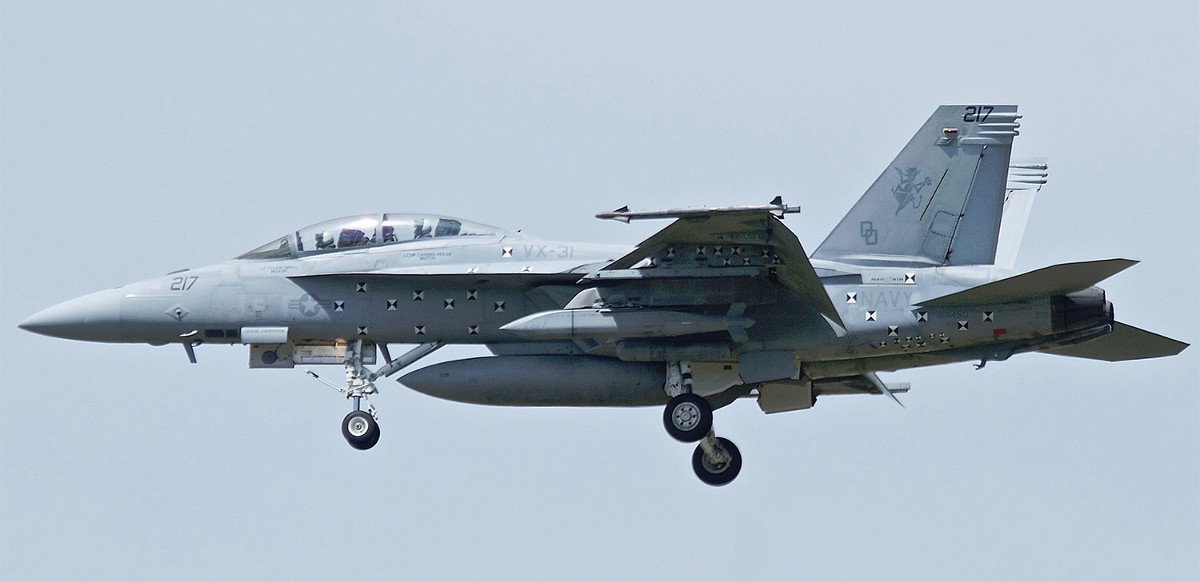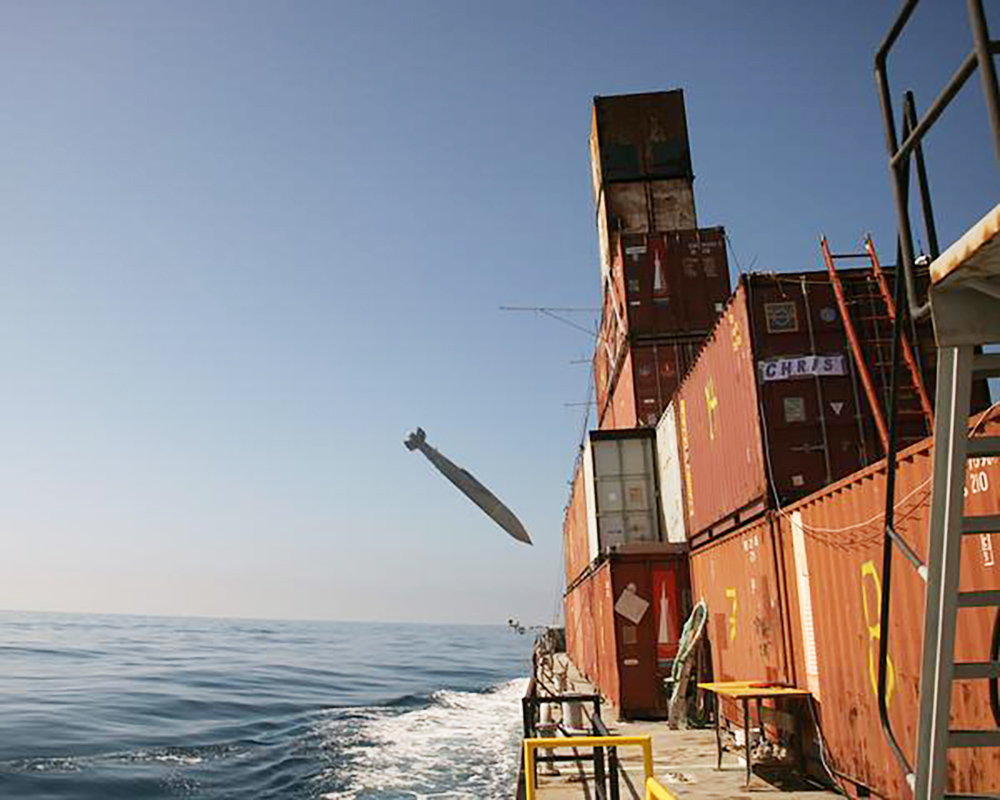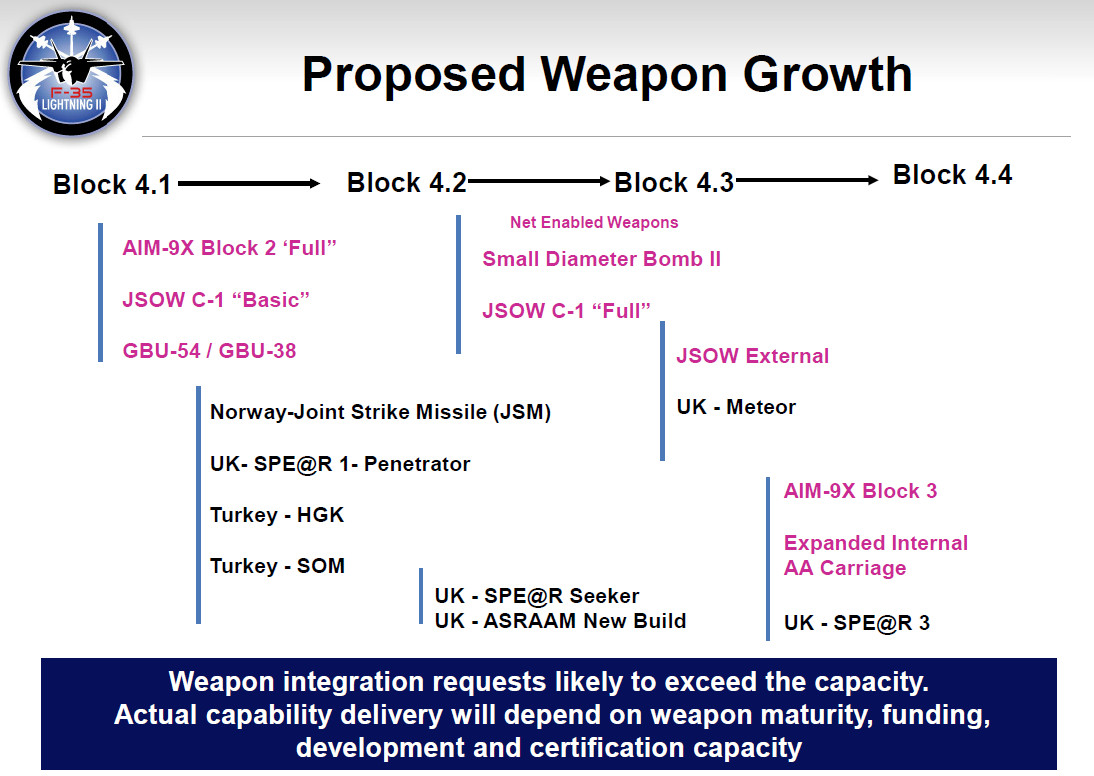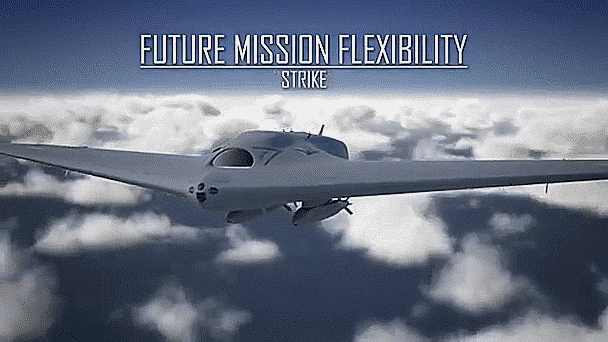Just recently, Raytheon announced that it had finished the work necessary to integrate its AGM-154 Joint Stand-Off Weapon glide bomb, or JSOW, into the internal weapons bays on the U.S. Navy’s F-35C Joint Strike Fighter. It’s an important development, especially given that the service is also developing a powered version with quadruple the range, but half the cost of other available air-launched cruise missiles.
Earlier in April 2018, the Massachusetts-headquartered defense contractor declared that the F-35C was fully capable of carrying the AGM-154 internally and that the pairing would now move on to operational testing. The goal is for the weapon to reach initial operational capability as an internal option on the Navy’s variant of the Joint Strike Fighter, or JSF, at some point in 2019. On April 23, 2018, the Navy also announced plans to proceed with the next phase of development of a powered AGM-154C variant, also known the Joint Stand-Off Weapon Extended Range, or JSOW-ER.
Stand-off firepower for the Navy’s F-35Cs
“This is absolutely a critical opportunity for the Navy because now this is their top-line, medium-range precision strike weapon that is capable now of being integrated internally on JSF,” Mark Borup, a representative of Raytheon’s Medium-Range Strike and Attack Air Warfare Systems Division, told Military.com in an interview on April 10, 2018. Carried internally, the weapons will allow the service’s F-35Cs to attack targets from a safer, stand-off distance even when in full stealth mode. There are plans in the future to allow the jets to carry it externally, as well.

As it stands now, the JSOW is the only stand-off air-to-ground weapon the Navy has a firm timeline for adding as an internally-carried option for its F-35Cs. The service has two versions of the 1,000-pound class weapon, the AGM-154A-1 and the AGM-154C-1.

The AGM-154A-1, or JSOW-A, has a BLU-111/B high explosive bomb inside. This type is particularly useful against troops, light vehicles, and surface-to-air missile sites out in the open.
The latter target set is particularly important and the JSOW-A gives U.S. Navy carrier-borne aircraft an important stand-off means of attacking enemy air defenses to help clear the way for follow-on strikes. Combined with the F-35, it could be an especially capable option for neutralizing threats to pave the way for subsequent missions by non-stealthy platforms.

The AGM-154C-1, or JSOW-C, is a bunker-buster that can punch through hardened structures thanks to a specialized warhead, known as the British Royal Augmentation Charge or BROACH. U.K.-headquartered BAE Systems is responsible for this part of the weapon.
BROACH is actually multiple explosive payloads stacked together. The weapon uses a 220-pound initial charge to pierce reinforced concrete and other barriers and a second 320-pound warhead with a delay fuze option to destroy whatever is inside.

A plane’s crew can also set the fuze to change the timing on the first explosion, either allowing the momentum of the weapon to provide increased penetration or setting off both charges at the same time. The latter mode would be more useful for destroying less robust buildings or fortifications or attacking targets out in the open.
Both AGM-154 variants use its pop-out wings to glide up to 70 miles when aircraft release it at high altitude. At lower altitudes, it can still sail approximately 15 miles from the launch point to its target. It also has a low-observable shape to help reduce the chance of the enemy detecting and attempting to shoot it down, and give them less time to do so even if they do spot the weapon before it hits its mark.

The two versions use GPS-assisted inertial navigation to guide them to the target and the pilot can also tell the guidance system to follow specific waypoints, to avoid enemy defenses or other obstacles, and set the optimal angle of attack, such as a shallow glide or a diving strike from above. A two-way data link allows the launching platform to send new instructions to the weapon in flight, as well.

In 2007, Raytheon also began development of an AGM-154C Block III subvariant with an improved guidance system, which became the AGM-154C-1, which adds an imaging infrared seeker to spot and home in on targets during the terminal stage of its flight. This improves this variant’s accuracy and gives it the ability to strike moving ships.
Two decades of JSOW
This is all a far cry from the weapon as it existed when it first entered service in the 1990s. The original AGM-154A version the Navy employed in the Balkans, Iraq, and Afghanistan relied in no small part on a payload of 145 small bomblets to make sure it hit the target.

Originally a joint U.S. Air Force and Navy program, the former service decided to stop buying new weapons in 2004, effectively dropping out of the project. Plans for an AGM-154B version with six “smart” Sensor Fuzed Munition bomblets, each with its own infrared sensors to locate and attack armored vehicles, came to an end after the Air Force decided instead to purchase the GPS-assisted inertial navigation system guided Wind Corrected Munition Dispenser cluster bomb instead. This complete system, known as the Sensor Fuzed Weapon, is significantly less expensive, but also has a far more limited stand-off capability than that of the planned JSOW-B.
The Air Force also pulled its remaining JSOW-A variants out of service after President George W. Bush’s administration issued new guidelines on cluster munitions in 2008. Though the Air Force’s F-15E Strike Eagle, F-16C/D Vipers, B-1B Bones, B-52 BUFF, and B-2 Spirits are all able to carry the weapon, the Air Force no longer employs any version of the weapon. At present, the Navy is the only U.S. military service to still field this weapon in any form, with the F/A-18C/D Hornet and F/A-18E/F Super Hornet acting the launch platforms. The service expects to keep JSOW in inventory at least through 2025 and does not yet have plans for a specific replacement weapon.
JSOW, and the JSOW-C in particular, has also enjoyed a certain amount of export success. Nearly a dozen foreign air forces – Australia, Canada, Finland, Greece, Netherlands, Poland, Taiwan, Saudi Arabia, Singapore, Turkey, and the United Arab Emirates – have or are actively considering purchasing the weapon. The primary launch platforms in those countries are various versions of the F-16 Viper and the F/A-18 Hornet, though the Saudis employ them on their F-15S Eagles.
JSOW has also since found itself overshadowed by other developments, especially with regards to Lockheed Martin’s low-observable AGM-158 Joint Air-to-Surface Standoff Missile, or JASSM, a turbojet-powered cruise missile with far greater range and its own multi-mode targeting and low-observable features. The standard AGM-158A notably saw its first operational employment on April 14, 2018, when B-1B bombers launched nearly 20 of them during a U.S.-led missile barrage against Syrian government chemical weapons sites.
Glide bomb to cruise missile
But its inclusion in and importance to the Navy’s F-35C plans may help breathe added life into the program once again. Most notably, the service is once again exploring the possibility of a powered JSOW-Extended Range, or JSOW-ER, cruise missile variant.
That idea is not new, with Raytheon first offering a proposed variant with the Williams International WJ24-8 turbojet for the U.K.’s Conventionally Armed Standoff Missile (CASOM) program. European consortium MBDA’s Storm Shadow cruise missile, which the Royal Air Force also employed in the recent Syria strikes, eventually won that competition.
Raytheon flight tested another ER variant in 2009, amid renewed interest and the possibility that the U.S. military might cancel the JASSM following poor test results. This version featured a Hamilton Sundstrand TJ-50 turbojet, which Raytheon uses on the ADM-160 Miniature Air-Launched Decoy system, and a flush-mounted intake to preserve the weapon’s low-observable characteristics. In 2012, Hamilton Sundstrand’s parent company, United Technologies Corporation, merged it with the Goodrich Corporation to form UTC Aerospace Systems.

In June 2017, the Navy revealed it was again moving forward with an evaluation of the JSOW-ER yet again. The Hamilton Sundstrand-powered version reportedly had a maximum range nearly 265 miles. This would give it slightly more stand-off capability that the regular JASSM, but the AGM-158B JASSM-ER would still outrange it by 300 miles.
More importantly, with the work already done in fitting the JSOW into the F-35C’s internal weapons bays, it could require less effort to integrate the powered JSOW-ER than with an entirely separate design. Hamilton Sundstrand type reportedly had the same dimensions as the standard AGM-154C-1
Lockheed Martin says it has plans to add JASSM to the Joint Strike Fighter’s arsenal, but it’s not clear when that might happen. And while JASSM is the same length as the JSOW, it’s wider, which might make it harder for it to fit internally on any variant of the jet, which could make JSOW-ER attractive to the Air Force as a future option on its F-35As. Unfortunately, the Marine Corps’ F-35B’s truncated weapons bays are already too small to accommodate the JSOW.

Foreign air forces already buying the F-35A variant and who already have stocks of JSOWs, such as Australia and the Netherlands, might also be interested in this type of stand-off capability. This might also help spread out the cost of integrating the JSOW-ER onto that version of the JSF.
It might make it a good stand-off option for any future unmanned combat air vehicles, as well. Interestingly, a promotional video Lockheed Martin put together to pitch its entrant to the Navy’s carrier-based MQ-25 tanker drone program, a portion of which is seen below, also includes a computer-generated rendering of an armed version, complete with a pair JSOWs.

A low-cost missile option
Cost might make the JSOW-ER a favorable alternative to other low-observable cruise missiles, such as JASSM or Storm Shadow, even on existing, non-stealthy aircraft. Lockheed Martin has found it difficult just to get the price of JASSM down to $800,000 apiece. Storm Shadow’s unit cost is still over $1 million.
As of 2008, Raytheon claimed that it could make JSOW-ERs for just $350,000 each. Even if that price point has doubled since then, a powered version could easily be competitive with the other options available on the market. In addition, Raytheon could potentially offer lower cost upgrade kits to customers who already own stocks of the older glide bombs to convert them into cruise missiles.

A lower cost, extended-range, air-launched cruise missile could be a boon for any air force that can’t necessarily afford or is otherwise having trouble acquiring a fifth-generation aircraft, but faces potential opponents with expanding air defense capabilities, too. As the range and precision of surface-to-air missiles, and the sensors that cue them, improves around the world, the desire for more and better cost-effective stand-off weapons will only increase in general.
They will also need to be relatively cheap if any country expects to be able to employ them in significant numbers for a protracted period of time without incurring prohibitive costs. The U.S. Air Force is separately tackling this cost issue, as well as others, in a program to explore the possibility inexpensive swarming cruise missiles. The JSOW-ER might provide a good starting place for that project, as well.
With a lower or competitive cost to JASSM, the JSOW-ER might also present a competitor to Lockheed Martin’s AGM-158C Long Range Anti-Ship Missile (LRASM) variant. This could be particularly appealing to the Navy if Lockheed Martin does end up having difficulty fitting the JASSM or LRASM internally into the F-35. The combination would give carrier battle groups a more survivable means of attacking enemy surface ships in complex and constrained battlespaces, such as the Baltic Sea or the South China Sea, where aircraft might face threats from both land- and sea-based air defenses simultaneously.

For the U.S. Navy in particular, having the gliding JSOW and powered JSOW-ER in its inventory makes heaps of sense when it comes to ‘kicking down the enemy’s door’ and crippling its air defenses. For the stealthy F-35, a hard to detect ‘low-observable’ or stealthy aircraft, JSOW provides enough standoff range to give the F-35 a good margin of survivability against advanced surface-to-air missile batteries. Meanwhile, the Super Hornet doesn’t have such a luxury but it could safely execute the same mission using the long-range JSOW-ER.
Other countries like Australia, Japan, and South Korea, that will be operating the F-35 alongside 4th generation fighters, could also leverage synergies of having both types JSOWs in service, especially for the destruction of enemy air defenses role. It’s a bit puzzling why the USAF wouldn’t also follow suit.
Novel payloads
And since Texas Instruments, the defense business unit of which Raytheon bought in 1997, designed the JSOW initially to carry modular payloads, it is possible that the system may have additional growth potential in the future. As noted, the defense contractor was already able to successfully developed a subvariant of the JSOW-A with an entirely different category of warhead, replacing dozens of individual submunitions with a unitary charge.
Another option might be the BLU-134/B bomb, previously known as the BLU-111D/B, which uses a cast ductile iron shell to create a larger amount of more uniform shrapnel as an alternative to cluster munitions. You can read about the BLU-134/B in greater detail here.
Other bunker-busting and low-collateral damage type warheads could also be future options, as well as improved sensor-aided cluster munitions. Future versions of the JSOW might be able to readily accept non-kinetic payloads, such as a high-powered microwave emitter that disables enemy electronics or another type of electronic warfare package.

The Air Force and the Navy are already working together on just such a program, called High-power Joint Electromagnetic Non-Kinetic Strike, or HiJENKS, which appears to be a spiritual successor to the Counter-electronics High Power Microwave Advanced Missile Project,
or CHAMP. Boeing made a limited number of the latter weapons using a modified version of the AGM-86 Air Launched Cruise Missile (ALCM).
So far, neither service has offered details about the platform that will carry this payload, though some have speculated it could be a JASSM-derivative. The final HiJENKS system, or a version thereof, might be able to fit inside a modified JSOW-ER, as well.
The U.S. Air Force video includes a computer-generated montage of potential future air warfare concepts, including a missile likely carrying a high-powered microwave weapon that blacks out an entire city. That segment begins at 4:00 in the runtime.

Possible hurdles
A longer-range, powered JSOW-ER might still end up being more costly in the end if it becomes necessary to add additional systems to help it operate autonomously in a GPS-denied environment or otherwise counter other emerging enemy defenses. Both JASSM and LRASM have specific features to help them get to their target even if they lose GPS connectivity or the beyond-line-of-sight data links get jammed.
The JSOW’s Block II upgrade did add components to help resist GPS-jamming, but this was based on the threat as it existed in the mid-2000s. Since then, concerns about hostile GPS jamming and spoofing, as well as other electronic warfare attacks, have only continued to grow.
LRASM also has onboard electronic support measures and radar warning receivers to help it automatically dodge threats. In addition to using its own infrared imaging seeker to prioritize targets, it can use those emissions to help classify them. It could lead to additional cost growth to add these additional capabilities onto the JSOW-ER.
Still, with the Navy having made it clear that it expects the JSOW to be the primary air-launched stand-off weapon available to its carrier strike groups for the foreseeable future, there will be an impetus to further improve the weapon. Its low cost and modular nature may allow the service to more easily entice either the Air Force or foreign partners to join in those efforts to help share the developmental and cost burdens.
All told, the JSOW could be heading toward a comeback with a host of new powered and unpowered variants competing against other, more expensive options.
Author’s note: High altitude range figure updated from 40 miles to up to 70 miles.
Contact the author: jtrevithickpr@gmail.com
